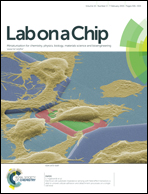Research highlights: cell separation at the bench and beyond
Abstract
We highlight recent progress in applying micro- and nanotechnology enabled cell separations to life sciences and clinical use. Microfluidic systems operate on a scale that matches that of cells (10–100 μm) and therefore allow interfacing and separations that are sensitive at this scale. Given the corresponding dimensions, it is not surprising that a wide array of microfluidic cell separation technologies have been developed using hydrodynamic, electrical, magnetic and optical forces, and have been applied to a range of biological and clinical problems in sample preparation. Passive separation approaches have distinct advantages for point of care applications or when downstream cell-based therapies are envisioned. We highlight a recent approach that allows for passive hydrodynamic filtering of cells over almost two orders of magnitude in flow conditions, which allowed the researchers to interface with a standard manual pipettor, creating a “microfluidic pipette tip”. In a second work, passive separation by size yields distinct populations of mesenchymal stem cells that can be used therapeutically. The researchers report on other biophysical separations that would be expected to refine these cell populations further for the most efficacious cell-based therapies. In an intriguing twist, we highlight a creative idea in which stem cell populations could potentially also be extracted from a patient with less invasive surgeries, performing the separation using magnetic nanoparticles in vivo without bulk tissue disruption. New cell separation technologies will continue to be demonstrated, however, a major research thrust appears to be now developing these technologies to address unique application niches in point-of-care sample preparation for research and diagnostics or cell-based therapies.


 Please wait while we load your content...
Please wait while we load your content...